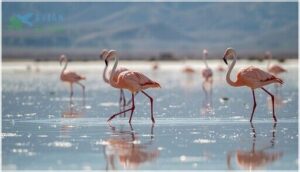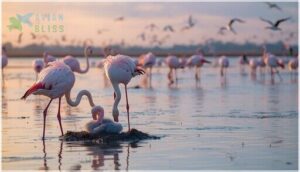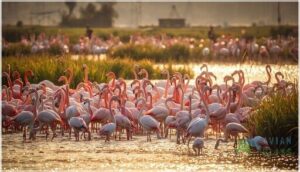This site is supported by our readers. We may earn a commission, at no cost to you, if you purchase through links.
A flamingo’s pink hue isn’t a birthright—it’s a badge earned through a lifetime of sifting muddy waters for microscopic crustaceans. These birds stand out in a crowd, not just for their color but for their stilt-like legs and S-shaped necks that seem to defy the laws of avian engineering.
If you’ve ever wondered how flamingos thrive in salty lagoons, or why their feathers range from pale blush to hot coral, the answer lies in a web of adaptations as striking as their appearance. Their story reveals a world where biology, environment, and survival are inseparable.
Table Of Contents
- Key Takeaways
- Flamingo Physical Characteristics
- Flamingo Habitat and Distribution
- Flamingo Feeding Habits and Diet
- Flamingo Reproduction and Life Cycle
- Flamingo Species and Conservation
- Frequently Asked Questions (FAQs)
- What information do I need to apply for Flamingo learning?
- What is Flamingo fares?
- How tall is a flamingo?
- What do flamingos symbolize?
- Why are flamingos so pink?
- Why do flamingos turn blue?
- What bacteria turns flamingos pink?
- What do flamingos eat in the wild?
- How long do flamingos live?
- Why do flamingos stand on one leg?
- Conclusion
Key Takeaways
- Flamingos owe their pink color to carotenoid pigments in their diet, not genetics, with feather shades reflecting what they eat.
- These birds thrive in extreme habitats like salty, alkaline lakes thanks to specialized bills, salt glands, and unique leg anatomy.
- Flamingo families share chick-rearing duties, feeding young with nutrient-rich crop milk and forming protective groups called crèches.
- Habitat loss, pollution, and climate change threaten flamingo populations, but international conservation efforts and migration strategies help them survive.
Flamingo Physical Characteristics
Flamingos stand out for more than just their color—you’ll notice some fascinating features if you look closer. Their bodies are shaped for life in the water, with a few surprising adaptations you mightn’t expect.
Here’s what you should know about the traits that make flamingos so unique.
Size, Shape, and Coloration
Size dimorphism is easy to spot in flamingos—males stand taller and heavier than females, yet both share that iconic S-shaped neck flexibility. Juvenile appearance is misleading; young flamingos look gray and drab, not pink.
Color intensity in flamingo feather color depends on diet, but some adults boost their flamingo physical attributes with cosmetic coloration, deepening their signature pink color. The vibrant hues come from carotenoid pigments found in their food.
Unique Bill and Leg Adaptations
If you think flamingos just stand around looking pretty, think again. Their filter-feeding bills work upside-down, sieving tiny prey with lamellae finer than a grain of sand. Leg bone ratios—tibiotarsus and tarsometatarsus nearly equal—give them that signature stilted stride. Joint kinematics keep steps fluid, while salt gland function offers osmoregulatory support for life in briny water.
The Andean flamingo thrives in high-altitude wetlands.
Plumage Color and Diet Connection
Flamingos’ stilted stride isn’t the only showstopper—their pink plumage is a living billboard for dietary carotenoids. Every shade, from blush to bold, is a direct result of betacarotene and carotenoid pigments in brine shrimp and algae. Pigment deposition in feathers, plus a touch of cosmetic coloration, keeps wild birds vibrant while captive management prevents fading.
| Diet Source | Pigment Type | Plumage Hue |
|---|---|---|
| Brine Shrimp | Betacarotene | Deep Pink |
| Blue-green Algae | Astaxanthin | Red-Pink |
| Formulated Feed | Synthetic Carotenoids | Pale Pink |
| Crop Milk | Protein/Fat | Grayish |
| Low-Carotenoid | Minimal Pigment | White |
Physiology for Extreme Habitats
That rosy glow is just the start—flamingos thrive where most birds wouldn’t last a day. Their physiology is adapted for extreme environments: Salt Gland Function lets them drink briny water, Alkaline Tolerance shields their legs in corrosive lakes, and Hypoxia Adaptations keep them active at high altitudes.
Even their Thermoregulation Stance and Guano Nutrient Cycling shape these wild, salty worlds.
Flamingo Habitat and Distribution
Flamingos aren’t picky about location, but their habitats have some quirks. You’ll find them in places where water and food come together in just the right way.
Here’s a look at the different environments these birds call home.
Geographic Range Across Continents
Imagine tracking flamingos across four continents—these birds don’t just settle; they spread. You’ll find African Flyways bustling with greater and lesser flamingos, Caribbean Strongholds hosting American flamingos, Andean Migration routes supporting high-altitude specialists, and Eurasian Populations reaching from Europe into Asian Habitats. Their habitat and location map a global tapestry:
- Africa’s Rift Valley lakes
- Caribbean coastlines
- Andean wetlands
Preferred Wetland Environments
Across flamingo habitat and environment, you’ll spot these birds favoring shallow lagoons and brackish waters, where water salinity and food availability hit a sweet spot. Wetland networks matter—a single flooded lake won’t cut it.
Hydrological regimes that keep mudflats exposed boost feeding, but human pressures and shifting water levels threaten these habitats, making persistence a balancing act.
Adaptations to Saline and Alkaline Lakes
Even in corrosive water where salt concentration rivals a kitchen’s worst spill, flamingos thrive by using salt gland function and caustic substrate tolerance. With specialized feeding habits—think filter feeding in alkaline lakes—they pull off impressive osmoregulation strategies.
When conditions shift, habitat relocation keeps them chasing food, proving their feeding specializations are as adaptable as their environments.
Flamingo Feeding Habits and Diet
Flamingos have some pretty fascinating ways of finding and eating their food. If you’re curious about what keeps these birds so vibrant and healthy, there’s a lot to discover.
Let’s break down the main feeding habits and diet essentials you should know.
Specialized Feeding Techniques
Ever watched a flamingo feed? Their filter-feeding kinematics are a marvel—lesser flamingos pump water through their bills up to 20 times per second. Thanks to unique bill morphology, adults skim and scrape for food at multiple depths.
Age-related development means chicks rely on crop milk, while resource partitioning and temporal patterns let flocks exploit wetlands without stepping on each other’s toes.
Primary Food Sources and Nutritional Needs
Did you know flamingo diet and feeding habits hinge on what’s swirling in their watery buffet? Algae consumption, brine shrimp, and insect larvae top the menu, fueling both adults and chicks. Crop milk, rich in protein, starts the cycle for young.
With every meal, flamingos drive nutrient cycling—redistributing dietary pigments, nitrogen, and phosphorus, shaping wetland ecosystems as they feed.
Role of Carotenoids in Feather Color
Ever wonder why flamingos flaunt those vivid pink feathers? Your answer lies in their flamingo diet and coloration. Dietary Carotenoid Intake drives feather color, transformed into ketocarotenoids for that signature hue. These pigments serve antioxidant functions, deposited during molt. And yes, feather color isn’t just for show—it’s a signaling trait, revealing health and foraging prowess.
Consider:
- Diet
- Transformation
- Antioxidants
- Molt
- Signals
Parental Crop Milk for Chicks
So, after those carotenoids work their magic on feathers, flamingo parents turn to crop milk for chick development. This nutrient-rich mix—58% fat, 35% protein—fuels rapid growth and immunity. Both parents share feeding patterns, delivering crop milk for weeks. Chick dependency duration varies, but strong immunological benefits mean chicks thrive, even in tough conditions.
| Crop Milk Composition | Feeding Patterns | Chick Development |
|---|---|---|
| 58% fat, 35% protein | Both parents feed | Rapid growth |
| Rich in immune cells | 3-hour intervals | Plumage forms |
| Amino acids, minerals | Up to 6 months | Filter feeding |
| Vitamins, moisture | Gradual weaning | Independence |
Flamingo Reproduction and Life Cycle
Flamingos have a fascinating way of raising their young, from courtship to caring for chicks. There are a few key stages that shape their life cycle and family structure.
Here’s what you’ll want to know about how flamingos reproduce and grow.
Courtship and Mating Rituals
How do flamingos turn courtship into a spectacle? Group displays kick off the breeding season, with synchronized mating choreography—think head-flagging and wing salutes—setting the stage for mate choice.
Seasonal triggers like rainfall spark these rituals, leading to pair bonding. Flamingo breeding behavior is monogamous for the season, with both sexes participating in elaborate flamingo reproduction and mating displays.
Nest Building and Egg Incubation
Once pairs form, you’ll spot them weaving mud nests—cone-shaped mounds built from mud, stones, and feathers—right on salty flats.
These elevated nests shield eggs from heat and flooding, boosting nesting success. Both parents share incubation duties, rotating the egg and adding fresh materials.
Incubation duration usually spans 26–31 days, with microclimate control key for healthy development.
Chick Development and Parental Care
After incubation, chicks hatch covered in gray-white down, relying on crop milk—rich in protein and fat—for rapid growth. You’ll notice crèche behavior as chicks join groups within a week, watched over by vigilant adults.
The weaning process stretches up to six months, with both parental roles important for:
- Feeding
- Guarding
- Guiding
- Vocal recognition
- Monitoring growth rates
Lifespan and Growth Stages
After about 70 days, chicks reach Fledging Age, swapping their gray down for Juvenile Plumage. You’ll see flamingo young development unfold over several years—full pink coloration and Sexual Maturity don’t arrive until age six.
Aging Patterns and Demographic Variation mean some individuals thrive for decades, especially in captivity, making the flamingo life cycle a lesson in slow, steady growth.
Flamingo Species and Conservation
Flamingos come in several distinct species, each with its own story and challenges. Their survival depends on a mix of natural instincts and human support.
Let’s take a closer look at the options that help protect these special birds.
Overview of Flamingo Species
Ever tried sorting flamingo species by size or color? You’ll find six extant types, each with its own flair. Plumage variation runs from pale pink to deep red, shaped by diet and habitat specificity.
The Greater flamingo stands tall, while the Lesser flamingo keeps things petite. Evolutionary history ties them together, yet species identification hinges on subtle physical and regional differences.
Conservation Status and Threats
From shrinking wetlands to toxic runoff, flamingos face a gauntlet of challenges. Conservation status varies—some species are near threatened, others vulnerable, none are currently endangered. Here’s what’s at stake:
- Habitat Degradation from mining and agriculture
- Climate Impacts altering wetland hydrology
- Pollution Threats from chemicals and fertilizers
- Exploitation Risks, like egg collection
Migration Patterns and Survival Strategies
Ever wondered how flamingos pull off their epic migrations? These birds read the landscape like seasoned travelers—drought, overcrowding, or food scarcity spark their nomadic instincts. V-formations slice through the sky, conserving energy as flocks cross continents, adapting altitude to dodge predators. Each species follows unique routes, turning migration triggers into survival strategies that keep flamboyances thriving.
Flamingos navigate vast migrations in V-formations, instinctively adapting routes and altitude to survive drought, overcrowding, and food scarcity
| Migration Trigger | Survival Strategy |
|---|---|
| Drought | Nomadism benefits |
| Overcrowding | Flight formations |
| Food scarcity | Altitude adaptation |
| Freezing lakes | Species routes |
| Human disturbance | Migration, conservation |
Ongoing Preservation Efforts
What keeps flamingos from fading into history? You’ll find a web of Policy Frameworks, Habitat Protection, and Threat Mitigation at work—think Ramsar sites, water-quality control, and global Species Monitoring.
These strategies fuel Population Recovery for endangered species, with targeted action plans and international networks ensuring flamingo conservation status improves, so flamboyances can thrive against mounting challenges.
Frequently Asked Questions (FAQs)
What information do I need to apply for Flamingo learning?
You’ll need Eligibility Verification, Application Deadlines, Required Documents like proof of course mastery, and details for Stipend Amounts. Employment confirmation is key.
For support, reach out to [email protected] if you run into questions.
What is Flamingo fares?
Imagine crossing Tampa Bay’s bridges with just one tap—Flamingo Fares is a Regional Transit Payment system offering Contactless Fare System access, Fare Capping Benefits, Multi-Agency Integration, and easy Account Management Features, streamlining your ride across multiple county transit networks.
How tall is a flamingo?
Species heights range from 5 to 5 feet, with greater flamingos topping out near 5 feet. Their stiltlike legs make up more than half their height, rivaling a child’s stature—an impressive flamingo physical characteristic in any wetland.
What do flamingos symbolize?
Flamingos represent Love Symbolism through lifelong partnerships, Balance Embodiment with their one-legged stance, and Beauty Icon via vibrant plumage.
As Spiritual Messengers and Cultural Significance, their behavior, physical description, and historical significance enrich global art, myth, and conservation efforts.
Why are flamingos so pink?
You see that vivid pink because dietary carotenoids from algae and shrimp undergo metabolic conversion, leading to pigment deposition in feathers. Feather coloration deepens as birds feed, and chick development starts gray, shifting pink with improved flamingo diet and feeding habits.
Why do flamingos turn blue?
Picture a painter with only pink, orange, and red on the palette—never blue. That’s how metabolic constraints and carotenoid conversion limits shape avian characteristics, so blue pigment absence keeps flamingo feathers pink.
Digital hoax debunking reveals myth origins.
What bacteria turns flamingos pink?
No bacterial species directly turns birds pink. Instead, Cyanobacteria Source—especially Arthrospira—delivers carotenoids in the flamingo diet.
Through Carotenoid Metabolism, these pigments impact feather color, as seen in both wild and captive coloration with Pigment Supplementation.
What do flamingos eat in the wild?
Imagine wading through shallow lagoons, filtering water with a specialized bill—your wild flamingo diet centers on aquatic invertebrates, algae, and tiny water organisms.
Species niches and feeding mechanisms shape nutritional roles, with carotenoid sources fueling vibrant feather color.
How long do flamingos live?
Wild Lifespan for flamingos usually ranges from 25–35 years, though some species, like the Chilean flamingo, can hit
Captive Longevity often stretches to 40–60 years, with Age Extremes shaped by Survival Factors and chick survival.
Why do flamingos stand on one leg?
Standing on one leg helps conserve energy and body heat, thanks to flamingo leg anatomy and biomechanical adaptations. This posture also limits parasite exposure and reflects behavioral context, making flamingos’ physical characteristics perfectly suited for extreme environments.
Conclusion
Like birds of a feather flocking together, flamingos show us that survival hinges on adaptation, not just appearance. Their pink plumage isn’t mere decoration—it’s a demonstration of the intricate dance between biology and environment.
From saline lakes to synchronized courtship rituals, each trait is a calculated response to nature’s challenges. If you look beyond the surface, you’ll see flamingos as living proof that thriving means embracing change, standing tall, and never losing sight of what sustains you.
- https://en.wikipedia.org/wiki/List_of_Phoenicopteriformes_by_population
- https://seaworld.org/animals/all-about/flamingos/habitat
- https://iucn.org/our-union/commissions/group/iucn-ssc-flamingo-specialist-group
- https://myfwc.com/wildlifehabitats/profiles/birds/waterbirds/american-flamingo/
- https://www.visittci.com/news/first-comprehensive-population-estimate-for-flamingos-in-turks-and-caicos












